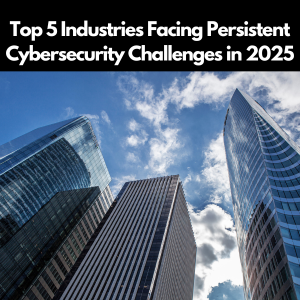Where foundational hygiene still lags—and what’s needed to close the gap.
Despite rising investment and regulation, some industries continue to face systemic challenges in cybersecurity. This isn’t about neglect—it’s about complexity. Legacy systems, competing priorities, and resource constraints often delay progress on core security practices. But attackers don’t wait. They exploit known gaps, targeting sectors where visibility, access control, and governance are still maturing.
Below are five industries where foundational cyber hygiene needs renewed focus—and where proactive, modernized solutions can drive meaningful risk reduction.
1. Manufacturing: Bridging IT and OT Security Gaps
Manufacturing remains one of the most-targeted sectors globally (IBM, 2024). The convergence of legacy operational technology (OT) and modern IT systems creates unique security blind spots. Many environments still lack proper segmentation, access controls, or centralized visibility. Threat actors—often nation-state backed—don’t need advanced exploits when basic protections are missing. With production uptime at stake, manufacturers need integrated security strategies that protect both legacy equipment and modern automation layers.
2. Finance & Insurance: Evolving Faster Than Security
Financial institutions handle some of the most sensitive data in the world—but face equally complex infrastructure. The sector is adopting API-driven architectures and AI-powered services at speed. Yet insider threats, inconsistent privilege controls, and siloed legacy platforms remain persistent risks. Nearly one-third of breaches involve internal actors. Closing the gap means better monitoring, unified identity controls, and security baked into DevOps and app development pipelines. The good news: many firms are actively prioritizing this shift in 2025.
3. Public Sector: Rich in Data, Slower to Modernize
Government agencies store vast amounts of citizen data but often operate on outdated infrastructure and fragmented systems. Attack volumes spiked 40% in a single quarter last year. While new policies like executive orders and the EU Cyber Diplomacy Toolbox signal progress, many agencies still lack centralized response frameworks and real-time threat sharing. Accelerating modernization—especially for legacy environments—is key to better resilience and coordinated response.
4. Retail: High Transaction Volumes, Inconsistent Controls
Retailers are high-transaction environments with sprawling digital footprints—from e-commerce platforms to POS systems. Unfortunately, many still struggle with foundational protections like secure payment processing and phishing defense. Social engineering continues to exploit employee trust more than technical flaws. With 37% of retail breaches involving payment card data (Verizon, 2024), PCI DSS compliance and phishing-resistant MFA should be baseline. For brands embracing omnichannel commerce, securing every digital touchpoint is now table stakes.
5. Healthcare: Protecting High-Value, Always-On Environments
Healthcare providers manage sensitive, regulated data and operate under 24/7 pressure. Yet budget limitations, legacy applications, and third-party integrations often result in weak access controls and unpatched systems. Breach costs in healthcare are the highest of any sector, averaging $9.77 million per incident (Embroker, 2025). Improving basic hygiene—patching, monitoring, segmentation—is vital. But the larger need is for security architectures that can operate without disrupting care delivery. Some health systems are leading the way, integrating security into procurement, digital transformation, and vendor management processes.
These industries aren’t falling behind for lack of effort—they’re navigating complexity. What’s clear is that foundational security still matters. Addressing identity, visibility, segmentation, and governance can close the door on the most common attack vectors. As regulation tightens and threats evolve, investing in core cyber hygiene will remain the first—and most critical—line of defense.
.png?width=1816&height=566&name=brandmark-design%20(83).png)



